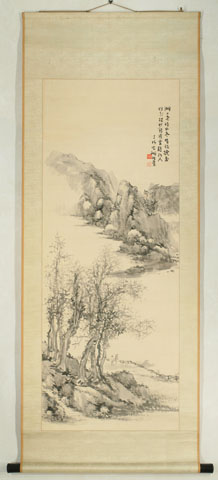Nanga
Winter landscapeSigned: Tôkai Seiko shiga
Seals: Seiko, Seiko myo Seiko iwa Seiko
Technique: sumi and somecolours on satin 152,2 x 59,3
Mounting: light green damask 203 x 77
Box: inscribed
Condition: very good
Inscription reads: 湖上尽梧好 冬晴稍挽春 桂花林抄發 哉處駐行人
At the far end of the lake the aogiri [Chinese parasol tree] enjoys sending the winter
On its way with fragments of spring. In the grove katsura [Judas tree] starts flowering
And manages to stop people passing by. (HK)
Okuhara Seiko was an independent unconventional female artist, one of the two leading female artists of the Meiji period.
She was the fourth daughter of a high-ranking samurai family in Koga, Ibaraki prefecture. Next to her masculine training in martial arts, she received a proper female education and received lessons from the Chinese style poet Onuma Chinzan (1818-91), Hirata Suiseki (1796-1863), who was a follower of Tani Bunchô, the calligrapher Oyama Kagai (1785-1864) and the rangaku (Western learning) scholar Takami Senseki (1785-1858).
Her desire to pursue a painting career in Edo ran contrary to clan laws restricting women's travel. Through her adoption by the Okuhara family she overcame this obstacle and moved to Edo in 1865.
Seiko quickly established herself at the foreground of Tokyo art and literary circles, and she even managed to get an invitation for an audience with the empress in 1872, the first female artist ever to receive such an honour.
During the 1870s and 1880s Seiko’s career flourished. It is said she trained hundreds of pupils at her school in Shitaya. Highly appraised colleagues like Yasuda Rôzan (1830-82) and Hakuryû paid her visits to exchange ideas.
After her studio had to move in favour of a railway, and when taste moved to western aesthetics, she retired at Kumagaya in 1891. During the two following decades after her retirement she traveled extensively.
Reference:
Koga 1998
Mito 2001
Fister ‘88 p. 161 ff.
Berry & Morioka ’08 p. 291-92
Jordan & Weston p. 116 ff.
Roberts, p. 125
Araki p. 2073
Price: SOLD

